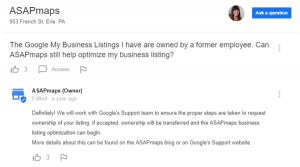
Back in 2015, there’s already been news that search engine giant, Google, is bound to release an algorithm update: the much-awaited Penguin 4.0. But the Holidays came and went, but nothing happened. As they’re no longer announcing these changes (unlike in the past), SEO experts and digital marketers are anxiously watching their analytics.
At the start of September of this year though, almost everyone in the digital marketing industry were surprised to spot some ‘interesting’ findings. The SEO community was buzzing because a lot of websites had ‘fluctuated’ in rankings. According to an article from Search Engine Land, there seems to be TWO updates: one centered around the core web search, the other on local rankings.
However, until today, Google has kept their lips sealed. The only thing they confirmed is that they’re arranging a release date – but of course, no one is talking.
**Note: This post will be updated accordingly for any new findings or reports. If relevant, a more comprehensive blog post on this topic may be published soon.
As industries from healthcare, education, legal, and commerce become affected by these ‘changes’, it’s time for SEO specialists to step in. What exactly can the Penguin 4.0 do once it officially rolls out (as of now, it seems to be at its testing phase)? How can website owners be prepared?
Rankings Down? Here’s Why
If you’re one of the few whose website went up due to the pending algorithm update, congratulations!
Not everyone is as lucky though. For most website owners, their rankings dropped – which means organic traffic is also affected. But as Google is not saying anything, you cannot assume that this is only due to algorithm updates. There are still other factors to consider if your rankings are down. A couple of these include:
- Black-hat link tactics OR Low Quality Backlinks – make sure links pointing back to your pages come from authoritative, relevant websites. Otherwise, Google might think you’re trying to game the system and penalize you.
- Lack of fresh content OR thin, duplicate content on pages – Are you regularly updating your on-site blog? Do your web pages provide enough information for online users? Did you check for duplicate content?
- Abrupt drop in the number of indexed pages – If you see sudden drops in the number of indexed pages for your website, it could mean that Google is having a hard time accessing your site. Other issues could be: duplicate content, non-canonicals, or meta noindex tags. Use the Search Console to learn more.
The important thing is NOT to panic! Remember: if you’re abiding by Google’s white-hat practices, there’s nothing to worry about. However, as Penguin 4.0 is coming, it’s vital to be prepared. If you have verified that your rankings are affected, perform a site audit.
2016 Site Audit 101
A site audit is basically getting an expert to check your site for challenges and opportunities using a variety of tools. There all kinds of audits: from links, content, to penalty and recovery. Although you can perform the audits yourself, it’s NOT advisable, because there are some things that only trained eyes can see.
During a general website audit, there are main things that SEO professionals look for. These are:
- Technical factors (i.e. hosting, caching, etc.)
- Onsite elements (i.e. meta tags and descriptions, content, page speed, etc.)
- Internal and external links
- Social media (i.e. existing accounts, engagement numbers, etc.)
Interested in doing a technical site audit for your website? Moz has an updated 2015 checklist to help you out.
Audits are typically done twice or once a year, just to check on the health of your website. But as there’s a pending algorithm update underway, this might be the best time to get one – just in case.
As SEO has evolved a lot since its spam link-building days, be sure to keep these top three Google ranking factors during your audit:
- LINKS – they still play a vital role in today’s SEO. Make sure your site has links in reputable and relevant websites. For low-authority sites, you can use the Google Disavow Tool OR directly send an email to the Webmaster to get the link removed (the latter is faster).
- CONTENT – are you producing high-quality, informative content? Are you paying attention to seasonal market temperatures? Do people find your content engaging enough to share with friends or family?
- RANKBRAIN – Take note that machines still can’t ‘read’ human language without complex mathematical formulas. By checking if your site caters to what RankBrain and your target market is looking for (natural language queries), then you should be good.
Do remember: the WRONG type of audit will be more costly to you. If you’re not sure, get expert advice. Being #1 requires assistance from the best in the field, after all.
Penguin 4.0: Don’t Forget Web Design
Aside from SEO, don’t neglect to check factors in web design, which include:
- SPEED – if users can’t access your site in three seconds or less, you may have a problem. Talk with your web developer to ensure quick loading speeds.
- BOUNCE RATE – don’t confuse bounce rates with exit rates. Bounce rates usually mean that people came on your site, didn’t like what they saw or found what they needed, and left. Although some bounce rates is expected (i.e. on your contact page), too high and it usually spells disaster for the long-term.
- MOBILE-FRIENDLINESS – with 4 out of 5 consumers using smartphones whenever they shop (to help with purchasing decisions), it can be considered sales suicide if you ignore mobile-friendliness. By using responsive web design (RWD), you can get your website to appear seamlessly across mobile devices.
Final Thoughts
If you’re practicing white-hat SEO tactics, there’s NO reason to fear algorithm updates. Continue doing what you do best: providing quality, informative content, ensuring you don’t pay for links, and managing your site’s user experience. Penguin 4.0 may be upon us – but SEO will continue to evolve to serve people first.
Digital & Social Articles on Business 2 Community(54)








